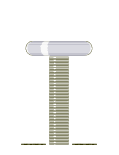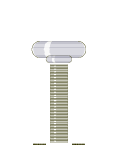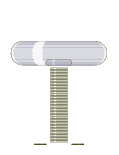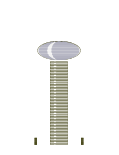(not to scale)





30.5"x6.5"
13"x4"
24"x6"
24"x10.5"
30"x9"
Some TC systems compared for their tuning and breakout characteristics.
The coils shown below are all tuned by their constructors to what they feel is the best tuning. We then model each setup in some detail, to examine the tuning of the coil, and to compare the available topload charge and field strengths with the observed breakout characteristics.
| System | Name | mm3p | jftt42a | jftt42b | mw1 | ba0 |
|---|---|---|---|---|---|---|
| Diagram (not to scale) |
 |
 |
 |
 |
 |
|
| Secondary | Length (meas) | 40.54" | 18.75" | 18.75" | 47.0" | 39.75" |
| Diameter (meas) | 8.712" | 4.2" | 4.2" | 9.9" | 8.438" | |
| Base height (meas) | 14.0" | 20.31" | 20.31" | 10.0" | 28.938" | |
| Turns (meas) | 2989 | 1307 | 1307 | 980 | 1789 | |
| Ldc (calc) | 383.5 mH | 36.6 mH | 36.6 mH | 46.0 mH | 131.4 mH | |
| Ldc (meas) | 36.7 mH (+0.3%) | 36.7 mH (+0.3%) | 131.1 mH (-0.2%) | |||
| Rdc (calc) | 425.8 ohms | 94.7 ohms | 94.7 ohms | 55.0 ohms | 103.0 ohms | |
| Rdc (meas) | 99.8 ohms (-3.1%) | |||||
| Primary | Diameter (meas) | 12.25"/34.75" | 6.25"/12.5" | 6.25"/12.5" | 26.0" | 11.1"/32.875" |
| Height (meas) | 14.0" | 19.685" | 19.685" | 10.0"/14.0" | 28.75" | |
| Tap/Turns (meas) | 23.95/25 | 14.5/18.5 | 16.5/18.5 | 4/4 | 13.5/15.3 | |
| Lpri (calc) | 356.6 uH | 63.0 uH | 81.3 uH | 18.3 uH | 102.1 uH | |
| Lpri (meas) | 58.2 uH | 75.1 uH | 102.0 uH | |||
| Input | Firing voltage (meas) | 33.9 kV | 26.599 kV | 26.599 kV | 8 kV | 22.3 kV |
| Cpri (meas) | 52 nF | 14.7 nF | 14.7 nF | 0.1 uF | 65.39 nF | |
| Bang energy (meas) | 29.88 J | 5.2 J | 5.2 J | 3.2 J | 16.26 J | |
| Topload | Geometry (meas) | Toroid 30.5"x6.5" |
Toroid 13"x4" |
Toroid 24"x6" |
Spheroid 24"x10.5" |
Toroid 30"x9" |
| Height (meas) | 58.54" | 42.661" | 42.661" | 63" | 77" | |
| Specific gradient (calc) | 0.052 V/cm/V | 0.100 V/cm/V | 0.068 V/cm/V | 0.056 V/cm/V | 0.044 V/cm/V | |
| Resonator | Cee (calc) | 44.7 pF | 17.6 pF | 31.9 pF | 33.5 pF | 39.5 pF |
| MCTV (calc) | 1156 kV | 769 kV | 571 kV | 437 kV | 907 kV | |
| Surface field at MCTV (calc) | 60.1 kV/cm | 76.9 kV/cm | 38.8 kV/cm | 24.5 kV/cm | 39.9 kV/cm | |
| Tuning | Fpri (calc) | 37.0 kHz | 165.4 kHz | 145.6 kHz | 117.7 kHz | 61.6 kHz |
| Fpri (meas) | 61.6 kHz (+0.0%) | |||||
| Fsec (calc) | 38.4 kHz | 198.3 kHz | 146.9 kHz | 127.8 kHz | 69.6 kHz | |
| Fsec (meas) | 196.0 kHz (-1.1%) | 147.0 kHz (+0.1%) | 69.7 kHz (+0.2%) | |||
| Primary offset (calc) | -3.7% | -16.6% | -0.9% | -7.9% | -11.5% | |
| Response | Vtop (calc) | 1011 kV | 414 kV | 517 kV | 254 kV | 601 kV |
| Surface field (calc) | 52.6 kV/cm | 41.4 kV/cm | 35.2 kV/cm | 14.2 kV/cm | 26.4 kV/cm | |
| Charge surplus | 15.2 uC | 2.1 uC | 3.8 uC | -4.7 uC | 0.3 uC | |
| Streamer-feet | 30.5 feet | 8.0 feet | 10.0 feet | 0.5 feet | ||
| Appendix | Waveforms Animation Surface Gradients Modes | Waveforms Animation Surface Gradients Modes | Waveforms Animation Surface Gradients Modes | Waveforms Animation Surface Gradients Modes | Waveforms Animation Surface Gradients Modes | |
| Breakout | Streamers | Multiple 80-90". | Tuned so that the sparks barely break out, 2 or 3 simultaneous streamers, If tuned for a higher frequency, then there are more streamers, but they are all shorter. | Seems to be right at the edge of breakout. There was only one streamer. | None without breakout point. | 1 or 2 streamers at a time. |
| Racing arcs | Never seen racing arcs on this coil. | Very close to creating racing sparks, but never appear. | No racing sparks. | Never. | No racings arcs. |
| Notes |
Some terms and definitions:
MCTV: Maximum Conceivable Top Volts - based on the estimated bang size and the calculated
energy storage capacitance of the resonator, and assuming perfect tuning and no losses.
Surface field: The highest E-field stress occuring on the surface of the topload.
Specific gradient: The surface field of the topload when at a potential of 1 volt.
Charge surplus: The excess charge in the topload, over and above that
required to lift the potential to the point of breakout. This represents the
surplus charge available to form streamers. A negative value is the amount
of topload charge by which the system falls short of breakout.
Streamer-feet
This is the average streamer length multiplied by the number of streamers, in
other words
the total combined length of all streamers. Calculated by
assuming that all the surplus charge is transferred to streamers at
1pF per foot.
| Comments |
This is very much a work in progress. Only the coil model BA0 is sufficiently qualified by measurement cross-checks to be relied upon, but there is a suggestion of a trend towards negative tunings, which is the expected behaviour. Hopefully the picture should become clearer as more measurements come in.